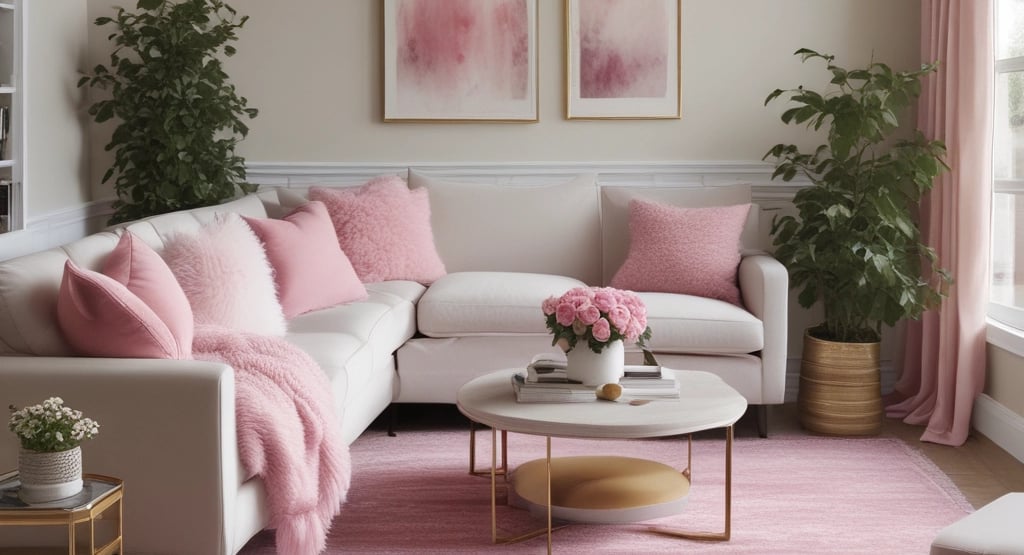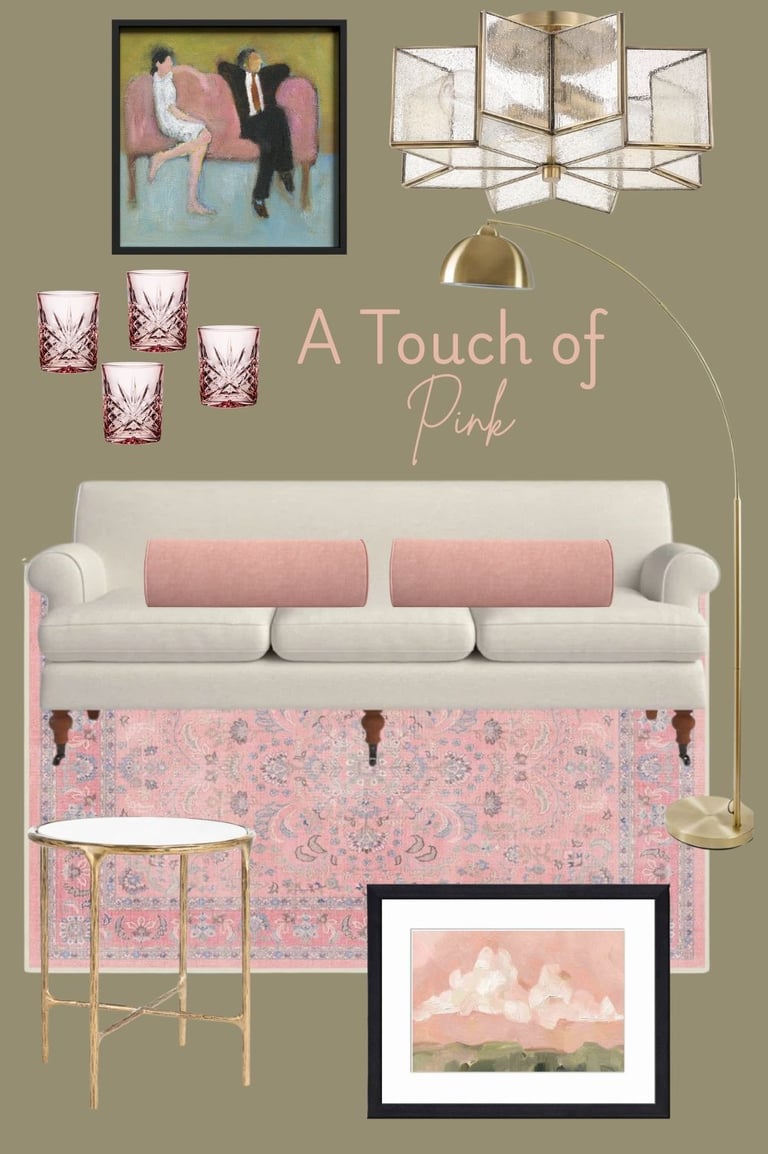Transforming Your Living Room With Pink Accents: A Complete SEO Guide
7/21/20255 min read


Understanding the Psychology of Pink in Interior Design
This post may contain affiliate links, which means I might earn a small commission (at no extra cost to you) if you decide to make a purchase through one of these links. I only recommend products I actually use or genuinely believe will bring value. Thanks for the support!
Pink, a color often associated with love, affection, and warmth, plays a significant role in interior design. When utilized thoughtfully, various shades of pink can effectively transform the ambiance of a living room, influencing emotions and perceptions. For instance, lighter shades like blush or pastel pink evoke feelings of calmness and tranquility, making them ideal for relaxation areas. These soft hues can create a serene atmosphere, promoting socialization and comfort, while bright, vibrant shades such as fuchsia infuse energy and creativity into the space.
The psychological effects of pink in interior design are backed by extensive studies. For many, pink is inherently comforting, often triggering feelings of safety and ease. This is particularly beneficial in living rooms, where families and friends gather to connect and unwind. Different shades of pink also possess unique qualities; peachy pinks may bring about a sense of warmth and hospitality, while cooler pink tones can evoke modern sophistication. This range offers designers and homeowners flexibility in crafting an ambiance that reflects personal style and mood.
Historically, pink has undergone considerable evolution in its associations within design. Initially perceived as a color primarily for children, it has emerged as a significant player in adult aesthetics. Today, designers leverage pink's versatility, presenting it in various contexts—from accent walls and furniture to decorative elements and accessories. By embracing pink, one can create a living room that not only feels inviting but also serves as a canvas for self-expression. The rich psychological backdrop of pink, aligned with its diverse shades, provides ample opportunities to foster a harmonious living space that resonates with comfort, creativity, and warmth.
Choosing the Right Shades of Pink for Your Living Room
When it comes to transforming your living room with pink accents, selecting the right shades of pink is crucial. Pink is a versatile color that can evoke various emotions and atmospheres, ranging from soft and calming to bold and energizing. To begin, consider the existing décor and overall style of your living room. If your space leans towards modern and minimalistic, opting for pale pinks or dusty rose can create a serene backdrop without overwhelming the senses. In contrast, vibrant fuchsias or magentas can introduce a playful element, perfect for contemporary or eclectic designs.
Coordinating pink with other colors is equally essential to achieving a harmonious look. Neutral tones such as white, grey, and beige pair beautifully with softer pinks, providing balance and a breath of fresh air. On the other hand, if you choose to work with deeper or bolder pinks, consider complementing them with rich jewel tones like emerald green or royal blue, which can create dramatic contrast and visual interest. Additionally, earth tones, such as terracotta or muted browns, can ground brighter pinks, adding warmth and richness to the space.
Lighting is another critical factor influencing the perception of pink in any room. Natural light will enhance softer shades, making them appear airy and inviting, while artificial lighting may highlight different undertones in your pink accents. Always test your selected shades in the light your living room receives throughout the day to ensure that they evoke the desired ambiance. Finally, incorporating various textures and materials, such as fabrics, wall colors, and decorative items, can elevate your chosen shades of pink, resulting in a cohesive and visually appealing living room design.
Incorporating Pink Accents Effectively
When it comes to transforming your living room with pink accents, strategic integration is essential for achieving a balanced and inviting atmosphere. Begin by selecting items that will serve as focal points, such as cushions or throws in various shades of pink. These elements can easily be mixed with neutral tones to maintain a sophisticated look. Opting for a geometric pattern or textured fabric can add depth and interest without overwhelming the space.
Another effective method is to incorporate pink through rugs. A pink area rug can anchor the furniture within the room, providing a warm and cohesive touch. For added creativity, consider layering a smaller pink rug over a larger one in a contrasting color, which can create a unique visual appeal while emphasizing your design style.
Artwork is yet another avenue for bringing pink into your living room. Whether it is a canvas painting featuring predominantly pink hues or framed photographs with hints of coral or blush, these pieces can add personality and vibrancy. Positioning these artworks at eye level enhances their impact, making them central to the room's aesthetic.
Furniture pieces like accent chairs or ottomans can also serve as significant pink accents. When choosing furniture, aim for items that combine functionality with a splash of color. A pink armchair can provide both seating and visual interest, particularly when paired with complementary colors or patterns in the surrounding décor.
Finally, thinking outside the box with DIY projects can open new possibilities for integrating pink accents. From repainting old furniture in a soft pink to creating custom pink wall art, these personal touches will infuse your living space with creativity and style. By thoughtfully incorporating pink into your living room, you can curate a space that is both vibrant and harmonious, reflecting your personal taste.
Maintaining a Balanced Aesthetic With Pink Accents
Incorporating pink accents into your living room can dramatically alter its ambiance, providing a blend of warmth, playfulness, and sophistication. However, achieving a balanced aesthetic is crucial to ensure that the pink elements enhance the overall décor rather than overwhelm it. To maintain harmony in your living space, it is essential to evaluate how the various shades of pink interact with the existing color palette and furnishings. Select shades that correspond well with the dominant colors in the room; for instance, soft pastels may complement neutral tones, while vibrant fuchsias can add energy against darker backdrops.
Consistency is key when incorporating pink throughout your living room. You might start with larger items, such as a pink couch or area rug, and then build upon these central elements with decorative cushions, artwork, or vases that include varying intensities of pink. This approach creates a cohesive look, ensuring that each pink accent feels intentional and interconnected. Periodically reassessing the arrangement of these elements helps to maintain freshness and avoids monotony over time.
Updating pink accents seasonally can also breathe new life into your living room, adapting its atmosphere throughout the year. In warmer months, consider incorporating lighter shades of pink through textiles or floral arrangements. During colder months, opt for deeper hues that evoke coziness. Rotate accessories, such as throws and cushions, to reflect seasonal themes while keeping pink as an integral part of the design. These small adjustments allow you to embrace the vibrancy of pink without necessitating a complete redesign, ensuring your living room remains both stylish and inviting across seasons.


